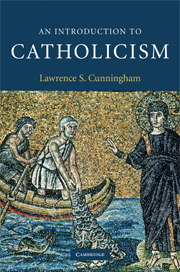Book contents
- Frontmatter
- Contents
- Illustrations
- Preface
- Acknowledgments
- 1 The many meanings of Catholicism
- 2 Roman Catholicism
- 3 Being Catholic: Some typologies
- 4 Catholicism in place and time
- 5 Catholic worship
- 6 The rule of faith
- 7 Catholic spirituality
- 8 The missionary character of Catholicism
- 9 Catholic reformation(s)
- 10 The moral life
- 11 The contemporary Catholic Church
- 12 Reading Catholicism: Bibliographical resources
- Index
- References
11 - The contemporary Catholic Church
Published online by Cambridge University Press: 05 June 2012
- Frontmatter
- Contents
- Illustrations
- Preface
- Acknowledgments
- 1 The many meanings of Catholicism
- 2 Roman Catholicism
- 3 Being Catholic: Some typologies
- 4 Catholicism in place and time
- 5 Catholic worship
- 6 The rule of faith
- 7 Catholic spirituality
- 8 The missionary character of Catholicism
- 9 Catholic reformation(s)
- 10 The moral life
- 11 The contemporary Catholic Church
- 12 Reading Catholicism: Bibliographical resources
- Index
- References
Summary
INTRODUCTION
One of the persistent threads running through this book is the tension which may erupt between Catholicism's past and its present. It is always a challenge to rise up to the challenges of the legitimate need for reform while attempting to balance that need against the task of fidelity to the past. There is no doubt that the Catholic Church attempts to be faithful to its ancient Tradition; of fidelity to the apostolic teaching of which it claims to be a guardian just as it treasures many parts of its lesser traditions as they have come down to us over the centuries. The constant risk inherent in any ancient historical religious tradition is either to turn its reverence for Tradition and traditions into an ossified set of articulated beliefs and practices in the name of that tradition or, contrariwise, to quickly jettison the past in the name of some putative “relevance” for the present exigencies of life. In the former temptation, a religion runs the risk of becoming a museum in which practice and idea are trapped in amber or held onto because of nostalgia. Giving in to the latter temptation runs the risk of modishness by not remembering that today's relevance may be tomorrow's fading faddism.
As we have seen in detail when thinking about reform within the Catholic Church, the Catholic Church is always conscious of the fact that, until the end of time, the Church in this world is never at a state of perfection.
- Type
- Chapter
- Information
- An Introduction to Catholicism , pp. 241 - 268Publisher: Cambridge University PressPrint publication year: 2009

